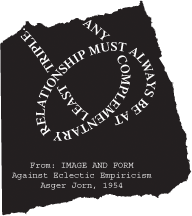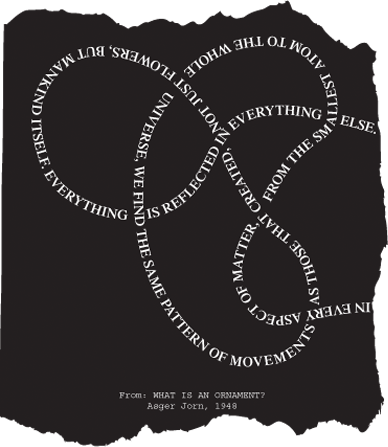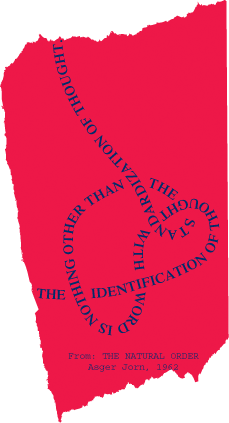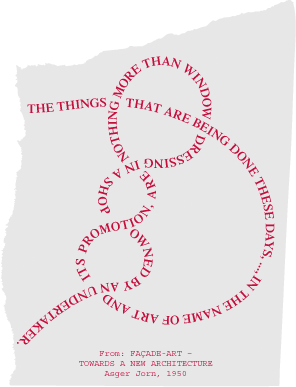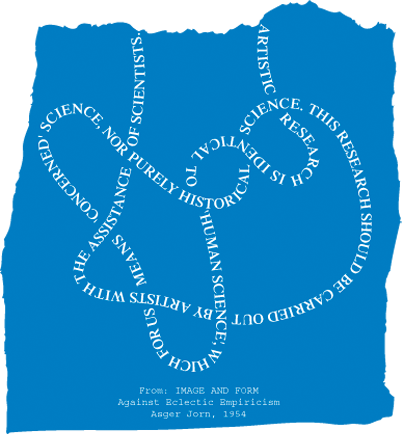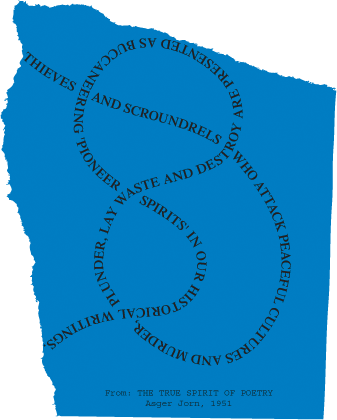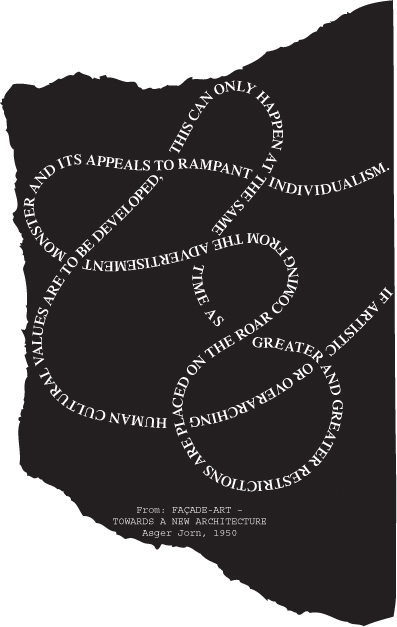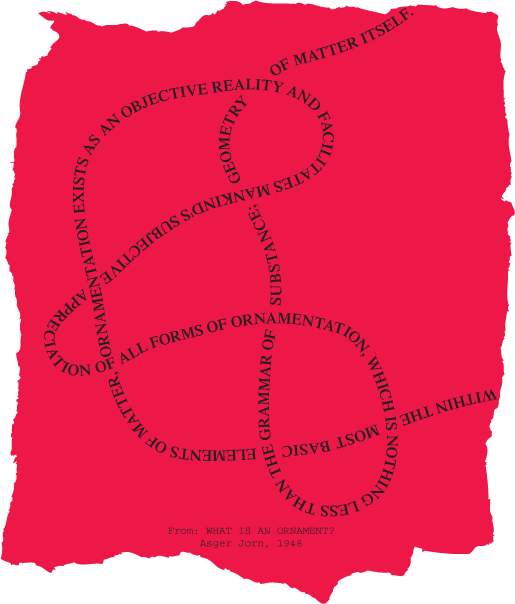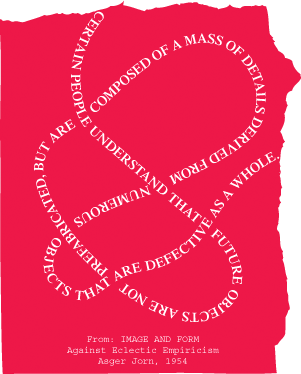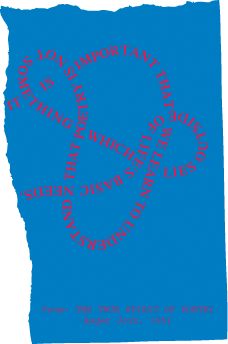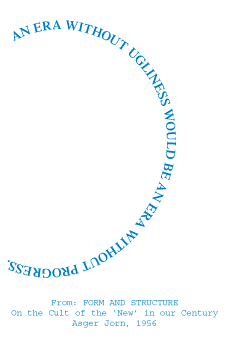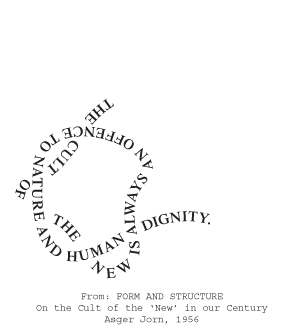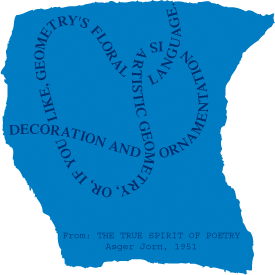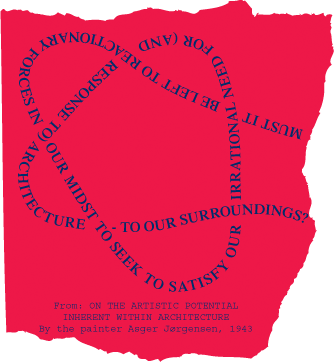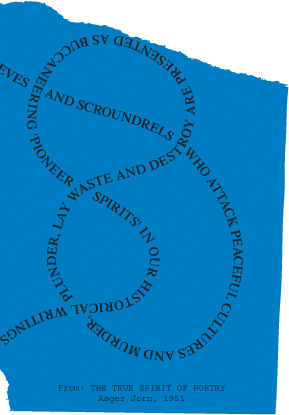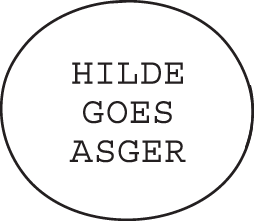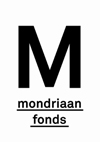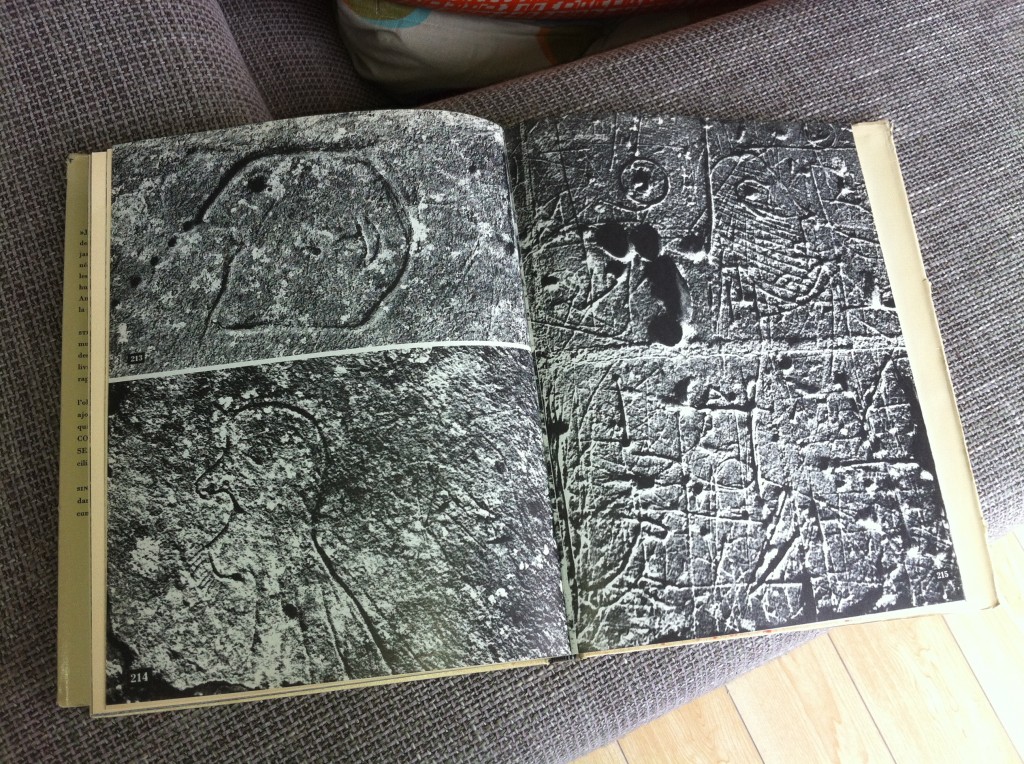ASGER JORN: THE SECRET OF ART
The text below is also part of the publications Asger Jorn: the Form and Beyond, edited by Luca Bochicchio and Paola Valenti, Genova University Press, Italy, November 2014, and Asger Jorn: The Secret of Art, Cobra Museum of Modern Art, Amstelveen, The Netherlands, 2014 (limited edition, designed by Richard Niessen).
The public sessions in the framework of hildegoesasger.org at the Athens Biennial 2013 and at Casco, office for art design and theory in Utrecht early 2014, built the basis for this text.
After having worked exclusively with contemporary art for about ten years, I started a job as a curator at the Cobra Museum of Modern Art in the winter of 2011. This called for refreshing my knowledge of Cobra, the loose constellation of young left-oriented artists and poets that officially existed from 1948-1951. The energetic Danish experimental artist and thinker Asger Jorn (1914-1973), well-known as a painter and a co-founder of Cobra and one of its driving forces, attracted my special interest. He was always on the move looking for international exchange and discussions, creating collaborative work, magazines, and exhibitions. What I have learned since 2010 is that Jorn, with great thrive and ambition, also wrote numerous books and articles envisioning, from an artistic point of view, ‘the first complete revision of the existing philosophical system’.
In his writings Jorn combined ideas from a wide variety of disciplines including politics, physics, economics, philosophy, anthropology, structuralism and art theory. The way he brought these various interests together in complex and unconventional ideas and ways, in search of a comprehensive theory of art and life, appeals to me for various reasons; especially his strong ideas on art as not derived from an ideology or worldview, but as the direct expression of an attitude towards life, belonging to the fundamental level of work and production. Jorn’s views result in a very outspoken position in the philosophical debate about the value of art and the position of the artist in society. In this perspective, art historian Graham Birtwistle makes the crucial observation that: “(…) in placing [art] at the basis and not in the superstructure, Jorn’s theory gives to art both a primary role and a certain independence from conventional ideological idealism.”[1]
Over the past years (and currently) the value of art and the position of the artist in society has been a much discussed topic in several European countries. Politicians announced budget cuts and other vigorous measures for the cultural sector in the light of the (ongoing) credit crisis. I wondered if the questions that Jorn posed and the position he took could still be relevant for the analysis of our current situation. Could Jorn’s theory, and more important his (art) practice, give us “certain independence”, as mentioned by Birtwistle, with our society transforming at a rapid pace from ‘market economy’ to ‘market society’?
After reading an essay by the Belgian sociologist Pascal Gielen I realized that Jorn, who had strong political views and anti-capitalist ideas, might have shared Gielen’s perspective on the current situation in Western society as one of ‘repressive liberalism’.[2] He defines repressive liberalism as a situation in which the state embraces ‘freedom’ and the ‘free market’, whereas the control of that freedom has in fact increased. The result is an extremely conditional form of freedom, or freedom as an instrument of control. Within this, Gielen says we are facing a situation of political dialectics replaced by a bureaucratic middle class that aspires to a measurable and controllable mediocrity.[3] Indeed a contemporary echo of Jorn’s words:
“For an elite to have real power it must have rights and regulations other than the rest of the population, it must form an extraordinary order. As this monopoly is abolished in modern democratic society, the administrative posts can only be occupied by the best amongst the mediocre, chosen from the good citizens. The disorderly and the extraordinary, the poor and the best are excluded automatically … .”[4]
Gielen also states that in fact, the past ten years the jargon of liberalism has been embraced with surprising and quite uncritical easiness, using politically charged language (including terms such as culture consumer, entrepreneurship, marketing) as if it were neutral, as if it were devoid of an ideological signature. He points out that anyone who nowadays opposes the rhetoric of repressive liberalism is labelled a naive romanticist. Isn’t this perhaps one of the major problems with what Jorn has to offer us as well? That it is hopelessly romantic? What could be distilled or taken from Jorn’s way of thinking to practise a genuinely critical art towards culture in our times?
The spice of life
Not surprisingly, Jorn never showed any hesitance in advocating and claiming an essential role for the arts in life and society. He wrote:
“What we are talking about here is art and its justification, its meaning and its place in our lives and society. Art does not exist simply for the enjoyment of beauty, nor to point a moral finger. Aesthetics and ethics are nothing more than playthings for philosophers and theologians. Art is a life and death issue; a human necessity. What I am referring to here is the creative, artistic urge and its sets its stamp on all our actions (…). There are core life values which can only grow in freedom, and only when truly free can they form a central part of the way we lead our lives.”[5] He even goes as far as to claim that: “There is a widespread misconception that one’s daily bread takes precedence over the spice of life and that we must all have practical homes before we can even start thinking about putting up frivolous buildings.”[6]
With the above statement Jorn wasn’t simply trying to advocate freedom for the arts for the sake of the arts. In all his texts he kept on expressing in various ways that this freedom was essential to be able to experiment and consequently essential to the generating of new knowledge. According to Jorn, this made it crucial for human society and the human race to develop further. In order to do so artists would need, what he called “free or unused energy”, which he identified as a potential scarcity in a (capitalist) society that claims all available energy. Almost cheekily, Jorn added that strictly speaking, the arts are not necessary. It only is if one desires progress. And if so, one of Jorn’s prerequisites to opening up the possibilities for an effective utilisation of the artistic possibilities would be “that society can afford, and is at liberty, to give architects and artists a free hand in the creation of the best environment for mankind.”[7]
The give-and-take between artist and society was of great concern to Jorn, as this citation also shows. In “Value and Economy …” he reflects on the topic at length and states that artists (and other cultural producers) are in fact exploited by the power elite and that “Art and culture retain only a minimal part of the sums that they earn”[8] as artists and other makers are not paid for their hours of productive work. He builds up his arguments in great detail but it might be most effective to present his example: “If the Americans just paid according to the tariff for the time they occupy themselves with European culture, then the whole of Europe could live off it.”[9] It would be obvious to conclude that Jorn simply argued that from now on artists and other makers should be paid for their hours of productive work[10] (especially as he also stated that the aim of his text “Value and Economy …” is to demonstrate the economic basis that ‘the creative elite’ is entitled to), but he loved undermining and contradicting, and his arguments often had an unexpected twist. In this case he ends the very same paragraph by saying that if what he suggests would be realized, it would have the (I take it as undesirable) effect of “stagnation of our artistic culture”.
Jorn obviously was well aware of the fact that art has a lot to do with economics, at the same time though he often pointed to those aspects that can’t be measured in money:
“Art is a life form. It is mankind’s celebration (and maledictions on) all aspects of life that enliven us. Architecture is the framework upon which we build our lives but the arts are the living framework around life itself. Artistic creation is the spiritual and psychological sea in which we swim and which provides life-giving nourishment.“ [11]
It is in social interaction and spiritual immeasurable values that we can find what Jorn calls “the secret of art”:
“The secret of art consists in the simple fact that it is more blessed to give than to take, but also that this blessedness is dependent upon voluntary giving, so that what is given is felt as a surplus, a wealth, not a duty. This is the simple materialistic explanation of the value of the art work and for all other things called spiritual values. In relation to the practical values, art is thus a counter-value, the value of productive pleasure. Art is the goal for a discharge of energy without a precise goal, except the one that the receiver can discover. In this way, art is the source of benevolence, is what is called grace.”[12]
Holistic as this may sound, the artistic strategies that Jorn applied make him the exemplary model for the recalcitrant modernist artist to whose strategies contemporary artists – “problem solvers of social problems on a micro level (…)” – should return, according to Pascal Gielen. No safety, order and comfort, no self-management disguised as cultural entrepreneurship for the sake of calculability and controllability,[13] but the creation of problems and “creative destruction” is what Gielen calls for. It is true: “Asger Jorn loved difficulties. If there were none, he created them, for himself and others”, writes Wieland Schmied.[14] Risk was also an extremely important element in Jorn’s thinking and strategies, and certainly not a factor that he wanted to reduce to acceptable proportions, in the ‘entrepreneurial’ sense. “(…) I have never been interested in going anywhere unless I was able to go all the way to the extreme”[15], Jorn said. Gielen’s call for creative destruction bears strong similarities to Jorn’s fascination for vandalism as a potential creative act, and his (and those involved in the Situationist International) well-known strategy of ‘détournement’ – basically the adaptation of or variation on previous ideas or works, in which the newly created has a meaning that differs from the original one.
These and other artistic strategies worked very well for Jorn and the other people he was associated with, but as stated in the preface of Collectivism after modernism, recently reborn collectivism has little or none of the leftovers from its own rich past.[16] Rather than looking into specific artistic strategies that worked well for artists in the Cold War era (and which might or might not work well here and now), I suggest that we take two elemental questions to heart. The first question is whether we can find the inner conviction that art is an elemental need (and if we have the willpower, or are prepared, to put this idea into practice).[17] The second one has to do with the idea “that artisthood is not an individual fate (…) but can rest on a collective foundation of solidarity structures”,[18] as Gielen phrases it so rightly.
Perhaps this is a good moment to remember the lifelong stipend that Jorn passed on to the Belgian poet Christian Dotremont, and to bring up Jorn’s donation of over 1,500 art works by various artists to the city of Silkeborg (today at Museum Jorn). Or the donation of his premises in Albisola, Italy, to the community, on the condition that his artist-friend Alberto Gambetta could continue living there until his death and that it would become a public venue after that. These examples not only testify to what looks like solidarity (or generosity) in various of Jorn’s actions. They also point to Jorn’s “second prerequisite to an effective utilisation of the artistic possibilities”: the artistic prerequisite,[19] to which collaboration between artists is a pre-given.
To Jorn collaboration and ‘brotherhood’ were vital and primary artistic solutions. Within these collaborations he regarded disciplinary boundaries of no importance, he rather advocated their abolition. He also rejected the idea of making compromises – so that everyone involved in the collaboration can give his best. The artists involved would share, what Jorn calls “the language of the new age”.[20] He wrote:
“It is the change-over to another rhythm of life in which the essential thing is not the emphasis on the private, the masterpiece, the individual, … not the division of life into closed-off forms, rubrics and classifications, but life’s own rhythm, luxuriance and free growth …,”[21] or: “it is not just a matter of creating an organic, living and cohesive architectural style, but also of creating a living lifestyle, an organic collaboration between human beings – an organic society in effect.”[22]
What is important to add is that to Asger Jorn, the idea of an ‘organic collaboration’ (or any other idea for that matter) takes the subjective, irrational side of human nature into account. To answer one of my initial questions: I can only agree with Jorn that this ‘romantic’ approach is in fact truly realistic.
Let us return to the second question: How to practise a genuinely critical art towards contemporary culture today? Perhaps it is not too far fetched to claim that in our individualistic society, focused on specialization and demarcation, collectivism by its very nature is genuinely critical (towards the art world’s system of individuality in particular). In her essay ‘Internationaleries – Collectivism, the Grotesque, and Cold War Functionalism’ Jelena Stojanović writes about influential European collectives which were all, with the exception of one, co-founded by Jorn: Cobra, International Lettriste, Mouvement pour un Bauhaus Imaginiste, and the Situationist International. She points out that they:
“took upon themselves the immense and utopian task of reimagining collective subjectivity. That is, of redefining the very notion of utopia for the cold war era, a time when the “colonization of everydayness” first took on an unconditional presence. They sought to achieve this gargantuan task by employing what they believed was the only available tactic: a critical art practice, informed by the cold war in which negation, debasement, and blasphemy were discharged against all highly promoted cultural values including “art”, but also the “avant-garde”.”[23]
Perhaps the second question to take from Jorn and his co-conspirators is whether we are up to reimagining collective subjectivity in a time of repressive liberalism.
[1] Graham Birtwistle, Living Art – Asger Jorn’s comprehensive theory of art between Helhesten and Cobra (1946-1949), Reflex, Utrecht 1986, p. 55.
[2] Pascal Gielen, “Repressief liberalisme – Over kunst, markt en cultuurbeleid in Nederland”/“Repressive Liberalism: The Dutch Cultural Policy System” (summary in English), Kunstlicht (no 1/2, 2013). Translations are my own and I refer to the Dutch text.
[3] Dito, p. 14.
[4] Asger Jorn, “Value and Economy – Critique of political economy and The exploitation of the unique”, published in French in 1959 by the Situationist International. In 1962 Jorn published “Value and Economy …” as Report no. 2 of the Scandinavian Institute of Comparative Vandalism. I refer to Peter Shield’s English translation in The Natural Order and other texts, Ashgate, London 2002, p. 203.
[5] Asger Jorn, ‘Architecture is not art’, 1943 translated by Paul Larkin in: Ed. Ruth Baumeister, Fraternité Avant Tout – Asger Jorn’s writings on art and architecture, 1938-1958, 010 Publishers, Rotterdam 2011, p. 53.
[6] Dito. Jorn’s words were not empty rhetoric, he and his family lived in very poor conditions for a long time. He was seriously undernourished by 1951, indicated as one of the reasons for him to get tuberculosis, and when he moved to Albisola, Italy with his family they lived in a tent along the riverside for a while.
[7] The painter Asger Jørgensen, ‘Notes on the Way’, 1945, in Baumeister, p. 82.
[8] “Value and Economy …”, p. 190.
[9] Dito.
[10] He literally meant that if I would amuse myself for one hour with a piece of art, a boxing match, chess game and so on, I would owe the maker/entertainer one hour of productive work.
[11] Asger Jorn, “Face to Face”, 1944, in Baumeister, p. 66 and 67.
[12] “Value and Economy …”, p. 184.
[13] Gielen, p. 14.
[14] Wieland Schmied, ‘The Graphic Artist Asger Jorn’, in Asger Jorn: The Secret of Art, Cobra Museum for Modern Art, Amstelveen 2014, p. 37.
[15] Asger Jorn, ‘Against Functionalism’, 1957 in Baumeister, p. 278.
[16] Ed. Blake Stimson & Gregory Sholette, Collectivism after modernism: the art of social imagination after 1945, University of Minnesota, Minneapolis/London 2007, p. xii.
[17] In line with this and Jorn’s concept of “a living art” Gielen mentions the need for artists who are capable of translating their strategies into “actual life forms” (werkelijke levensvormen).
[18] Gielen, p. 18.
[19] Asger Jorn, ‘Notes on the Way’ in Baumeister, p. 82.
[20] Dito, p. 83.
[21] Asger Jorn, ‘Formsprakets Livsinnehåll’ (The lifecontent of the language of form), Byggmåstaren, Stockholm, XXVI, 17, 1947, in Birtwistle, p. 317.
[22] Asger Jorn, ‘What is an ornament?’, 1948 in Baumeister, p. 206.
[23] Stimson & Sholette, p. 38.
ASGER JORN: PRODUCTION, CONSUMPTION, ADMINISTRATION
The chapter ‘Production, Consumption, Administration’ by Asger Jorn is part of the larger text “Sauvagerie, Barbarie et Civilation” which appeared in French in Signes gravés sur les églises de l ‘Eure et du Calvados: Asger Jorn, P-V. Glob, Gutorm Gjessing, Michel de Bouard [et al.], Collection: Bibliothèque d’Alexandrie v. 2, ed. Asger Jorn, published by the Scandinavian Institute of Comparative Vandalism, 1964.
English translation for www.hildegoesasger.org by Chad A. Córdova, 2014
PRODUCTION, CONSUMPTION, ADMINISTRATION
Consumption is self-production.
Among the antagonisms peculiar to economic structures, the most important, it seems, arises vis-à-vis the problem of locating causality in the relations between production and consumption. That is, do we create in order to consume, or consume in order to create? Which of the two activities is a function of the other? and, with this mystery solved, will we better know the agency [instance[1]] hiding behind administrative power, or, further, to what this agency itself is subordinate?
Earlier, we indicated that the events of economic reality arrange themselves in series that vary broadly depending on the zones of European culture — there are three of them — in which these events take place.
For Nordic minds, the importance of the link they establish between the past and the present distracts them from any purely current event or expression. If, exceptionally, they would like to concentrate their attention on such an event, they would be unable to keep themselves from bringing to bear on it everything from the past that, in their eyes, appears relevant — on the understanding that the most distant past will also be required to provide information.
Destruction and death — the end — are traditionally seen as passages towards the past. The problem with this attitude is that one can say that every complete process, in any domain whatsoever, always presents itself as a destruction of the given conditions. Moreover, destruction can take place without any benefit to superior creativity. The right to destroy is hence the sign of superiority. By refusing the peoples of the so-called barbarian invasions[2] any justification for the destruction they wrought, one remains faithful to the ancient hierarchical structure of the Roman Empire, a system by now totally bankrupt.
DESTRUCTION – CONSUMPTION
Viewed from without, each act of consumption presents itself under the guise of destruction.
In today’s economy, the instability of the production-consumption equilibrium is only apparent. We have here a false notion, which masks both the importance and the volume of production and consumption.
In actual fact, the considerable augmentation of the means of production, on the one hand, and of the needs of consumption, on the other, tends to create an absolute correspondence and equivalence between the two.
Indeed, we are moving towards perfect equilibrium.
Among the facts on the basis of which production “conceives of its products” is the conviction that consumption is essentially of a destructive nature. No creation of objects is undertaken without the addition of elements that will precipitate their consumption. Factors of destruction, these elements accelerate the objects’ demise.
Today, the life of the manufactured product is thus intentionally shortened from the outset. It is no longer durable, but ephemeral. Its consumption is no longer deferred, but immediate. Solidity and stability are no longer desired, and the Americans have even invented an expression to refer to these products guaranteed to not last long.
Considering this situation, vandalism seems to us to be simply a type of consumption like any other.
Just so, certain economists see war and wartime economy as one gigantic consumption. Essayists and philosophers assure us that production necessarily leads, in the more or less long term, to a wartime economy.
THE APPLICATION OF SITUGRAPHY IN EUROPE
Triolectic analysis alone is capable of dissipating the confusion generated by effects that, so far, have remained unrecognized. Thus the importance of methods for locating fundamental complementarities. How can these be detected?
We will take as irrefutable evidence that complementarity exists between two cultures the fact that, in one of them, the forces of Reaction[3] wield — with the intention of reining in progress — the progressive ideas of the other culture. Today in Europe we are witnessing precisely this sort of situation. One need only look to the North, to the South, to the East.
Geographically, the geometric layout of the capitals of the Latin countries[4] reflects a composition at once median, symmetrical and central. All roads lead to Rome; or to Paris; or to Brasilia.
Stockholm, Oslo, Copenhagen, London, New York: border cities turned, in reality, toward the unknown, and open to the foreigner [à l’étranger].
Like prewar Vienna, Berlin bore the traces of the character of the old Holy Roman Empire[5] created by Charlemagne. Exploiting Berlin’s status as border city was a constant of American postwar politics. The agreement [entente] with Russia will obviously displace the locus of this interplay [jeu] to Jerusalem — the border city of the “Christian nation.” The conflict between Abelard and Bernard is topical once again, but this time the answers are known in advance. Fascination is no longer possible, except for imbeciles.
At the core of any system or social organization, three complementary elements can always be located: production, administration, and consumption. The Latin, Germanic, and Russo-Byzantine systems differ according to each system’s unique method of applying these elements. The Latin system appears to be characterized, first, by the virtualization of administration and, second, by the actualization of the unity of production and consumption, a unity in which the proportion of the two components varies. The Germanic system is characterized by the virtualization of consumption, on the one hand, and, on the other, by the actualization of a fusion between production and administration. Finally, the Russo-Byzantine system is based upon the virtualization of production and the actualized fusion of administration and consumption.
Earlier, we pointed out the existence of a parallelism by which consumption resembles destruction. For the Germanic peoples[6] — and for them alone — the act of consumption is infused with and animated by the will to purity to such a degree that this will makes their system of consumption unique. On the other hand, the Latin principles of consumption permit, authorize, and promote a certain freedom of play, and do so without further restricting the same freedom of play in the sphere of production. But within the Latin framework, freedom of consumption — or of destruction — never becomes absolute, and remains always short of the “barbaric point” of the Nordic peoples.[7]
These different systems, which are responsible for different types of “mises en situation,”[8] led the Situationist movement to recognize and accept the diversity of these methods. It is because this movement deigned to examine their different natures in a critical fashion, that it was able to maintain its own homogeneity.
In the first years after the war, opposition to the traditional concept of art appeared under one of two forms. Some declared themselves in favor of a new sort of art, whose domain would stand in opposition to art understood according to its traditional concept [art classique]. Others were more radical still: they decided to deny the value of art in every domain by means of an anti-artistic mindset. In Latin culture, both the opposition to art and art’s marginalization were, of course, never absolute — this opposition being above all rhetorical. But it must be emphasized that this essentially rhetorical opposition, and which hence sets aside any personally adopted attitude as well as all sincerity, is of a terribly more radical nature than all other oppositions. Thus, in Paris, we witnessed this modern mindset — armed with the explicit intention of withdrawing all possibilities for freedom and development from art, and with the secret intention of transforming it into a means or instrument —, create a situation that strove for the complete annihilation of art as it had been known before [qui tend au vide complet].
This crisis of art, which we are experiencing today, finds its most extreme illustration in the conflict of the S.I. Deeply representative of the Nordic existential attitude in the artistic domain, this movement would gain in originality and authority if the ideas of the different minds that, in different capacities — philosophers, poets or thinkers — fall within Existentialism, were more familiar, and if the public had better knowledge of how these different ideas are interrelated. Thus, behind Kierkegaard hides Poul Martin Möller, a bit like how we find the genius of Socrates behind Plato’s system. Let us say in passing that there is no way one can believe that Socrates — originally a sculptor — would have consented to the exclusion of the liberal arts later professed by Plato.
Sartre committed the gross error of considering Kierkegaard’s scholastic system to be a humanism. Shortly before his death, Poul Martin Möller wrote a poem entitled “The artist among the rebels.” This poem recounts how, in 1830, a group of rebels in Paris entered into the studio of an artist with the intention of destroying his work, and how the attacked artist vigorously reacted with a violent counterattack. This poem, which served as grounds for its author to be classified as “politically reactionary,” must have made a profound impression on me. Remarkable for its great beauty, the poem is just as remarkable for its political character. Half a century after the imaginary clash it depicts, a similar conflict, only real this time, broke out during the Paris Commune. This poem seems, again rather prophetically, to have highlighted the contradictions that today have become internal to the S.I. as a result of how the movement’s unity has been put into question by Debord and all his followers.
The anecdote of the arsonists who, during the final days of the Commune, went to destroy Notre-Dame and encountered a battalion of armed artists, “constitutes a good example of direct democracy” and allows us to grasp, in terms of a specific instance, the ambivalence inherent in any act of protection that is a priori conservative. That is, against these men who wanted to accede to expression by translating their total defiance of a society of oppressors into a destructive manifestation, was the ensemble of artists right to unanimously defend Notre-Dame in the name of permanent aesthetic values? and ultimately, in the name of the spirit of Museums?
Partisans, politically speaking, of the Commune, “these artists acting as specialists found themselves in conflict with a radical expression of the struggle against alienation.” (Debord), Aux poubelles de l’histoire.
What happens when, at the end of a confrontation, one of the protagonists disappears? and, in particular, when, of the three elements involved, precisely the one that stood alone against the group of the other two is annihilated? Between the remaining two sides, whose union against the common adversary once formed an actualized antagonism, a schism is immediately produced. Depolarization polarizes the prior allies. A struggle arises for the possession of the goods, now up for grabs, of the vanquished adversary. The appropriation of these goods will set off in their future possessor a process of identification with the prior adversary; in other words, a new union representing a possibility for actualization. Every war and every confrontation strives to annihilate an adversary who is, at bottom, less real than virtual. This means that the demise of the latter in some ways actualizes its reality, and to such a degree that, at the end of the confrontation, we sometimes have the paradoxical impression that the loser is the winner. It goes without saying that, were the two surviving protagonists to lack the will to appropriate the goods of the now absent adversary, no combat would take place between them.
Debord no doubt betrays his mentality and Latin political pedigree by considering artists to be sheer specialists and, ultimately, mere instrumental means.[9] History shows that artists have always struggled against the apriorism of this notion. Their participation in all great revolutionary movements bears witness to this fact, and they have always considered this sort of utilitarian attitude towards art to be a form of oppression and an assault on their freedom. This oppression was adopted, made official, and legalized in 787 by the Second Council of Nicaea.
By approving the arsonists’ actions against the armed artists,[10] Debord fell into the trap Estivals had set. For years the latter has never tired of repeating that the affinity linking us together, Debord and I, is “something totally practical, without any basis in shared ideas.” Unfortunately, in this particular situation, in which a socialism and a barbarism confront one another, by lending his assent to arsonist vandalism, Debord is surely on the side of the barbarians. For — let us ask ourselves — by what means did those artists imagine they would destroy the arsonists? Quite simply: by recourse to Teutonic acts…
In a society in which military reality is all-powerful, seeking to determine the degree of barbarism in actions and behaviors is a vain undertaking destined for failure. Accepting vandalism implies, ipso facto, consenting to Teutonism [teutonism]. That Debord — engaged [engagé[11]] as he is today — could return to the conventional and accepted positions, which are in fact those of the Parisian avant-garde, seems to us to be neither desirable nor possible.
The concept of situation — this jack of all trades [concept à tout faire] of Existentialist thought, this pseudo open-sesame of an obsolete and misbegotten philosophy — did not get J.-P. Sartre very far. The vitality of Situationism lends a rather moribund appearance to Franco-German Existentialism, with its resting comfortably on an ensemble of old propositions — precisely those belonging to Danish Existentialism of the past century. Oblivious to its own derivative character, the French offshoot of Existentialism did not, however, entice Debord. Nonetheless, we have become the amused onlookers to a paradoxical spectacle: on the one side we have Sartre, who at first concerned himself with writing for future generations, was gradually forced into the contemporary, and then drowned in an excessive currentness. On the other side there is Debord, interested only in what is topical, who finds himself condemned to erect a distant future, and this in view of a posthumous glory to which, in fact, he is indifferent…
The Latin mind and the Latin character adapt themselves easily — naturally — to the existentialist credo, “live in the present.” For them the pure instant is an obvious truism, an immediate reality, while for Nordic thought and temperament — let us say, for Kierkegaard — the pure instant is a demented dream and a vain hope.
Fear that Cobra’s activity might lead to a unilateral Nordism led me to seek out the collaboration of a man in whom I saw, as a fertile promoter of new ideas, a possible ideal successor to André Breton. This man was Debord; and nothing since has made me change my mind about him.
STATE — FAMILY — NATION
In his study of the origin of the family, Friedrich Engels develops Marxist thought on the factors of human progress. To him this “progress” appears to pass through three phases: the savage stage — which is that of pure consumption, and corresponds to the non-productivity of hunters; the barbaric stage — characterized by production oriented towards consumption; and the civilized stage — which, producing simply in order to produce (outside of all consumption), is linked to the emergence of slavery. The slave was a producer to whom any and all right to consumption was denied. In forms deceitful and masked, Western society has created types of subjugation and servitude that in no way differ from ancient slavery.
All false judgments, errors, and illusions concerning the notion of progress are ruthlessly exposed by the triolectic system. It is impossible to create a valid opposition to barbarism without seeing savagery and slavery as one and the same thing, which, in essence, is civilization. Civilization is savagery justified by the moral obligation to maintain slavery. It is at once a material consequence and a social reality: production that leads to no consumption. To isolate the producer, to free the slave: these are the real ways to stand up to Barbarism, to Savagery. They comprise the program and goals of Socialism — a way of thinking that betrays the intention to “make peace” with the Savage, in order to recuperate for Civilization the force that animates him as a destructive force. Thus does socialism ingloriously resort to the tired opposition between civilization and barbarism. It attempts to draw production and administration closer together, and refuses to see that the union of the two represents nothing more than a new antagonism: an inexorable process, which is hell for all, and from which the Situationist International alone has freed itself.
Today we know that — as an expression of the will to social progress — each revolution engenders a superior social life, yet introduces into this very same life a greater degree of uniformity under the guise of stability, and ruthlessly restricts the freedom of all. The Situationist mindset is committed to trying to recover the rights to free human play, play aimed at reducing “alienation” [“Entfremdung”].
Graffiti — whether they are Norman, Parisian, or from somewhere else — are evidence of a desire for presence, and of an opposition to sacrosanct technique. An orientation such as Situationism runs the risk of seeming counterrevolutionary. In fact, such a movement allows us to clearly see the error committed by the engineer Sorel, who studied the revolutionary movements of this century in accordance with his tabula rasa system. At the start of the last century, Poul Martin Möller already sensed the possibility for error inherent in the following apothegm: A revolutionary movement is of value only during the stage preceding its practical realization. This formula can be taken in different ways, and can give rise to notions deriving from a mechanist reality. For example, one could understand it to mean that only during a downfall are energies, new and readily available, liberated; that after the downfall there comes about a new stage in which the energies become more obstructed than they were before. In this way, even the triolectic system is at once a springboard and an impediment: it frees up energies, then it blocks them from being used. Poul Martin Möller recognized this long ago: “A new idea is of value only while it is being absorbed into the masses. Once it is generally accepted, it loses its value.” It is hence obvious that on the day the oppositions dividing Europe into North and South disappear, exceptional sources of an admirable energy will, by the same token, also disappear. It is not merely a duty, it is a right to demand that this energy not be wasted on vain struggles, and that it contribute instead to general enrichment.
Among the histories of the Germanic peoples, Friedrich Engels’ seems to me to be the most intelligent and the most impartial.
To the question: “What was the mysterious magic charm thanks to which the Germanic peoples breathed new vital force into a Europe in agony?”, Engels provides an excellent response, without, however, completely explaining why the mere emergence of barbarism in a civilization was enough to create new sociological foundations — foundations both superior and enduring.
Engels tells us that: “The Germanic peoples were barbarians insofar as they were incapable of instituting complete slavery[12] in the sense that labor slavery in Antiquity and domestic slavery in the Orient were complete.” In the depths of the psyche, rights and duties are undifferentiated from one another. The notion of property as “fruit of personal labor” — the notion at stake here —, is thus invalid when applied to that sphere.
Engels continues: “Civilization engenders a class that is not occupied with production (nor with consumption), but only with the exchange of products: merchants.” Engels does not seem to see that, once liberated from the merchant class out of which it arose, this activity then shaped structures of the State. Thus it is with a certain frivolity that Engels states: “The gentilic organization ceased to exist and was replaced by the State”, and: “with the division of society into classes, the State inevitably falls; it is relegated to the museum of antiquities, next to the spinning wheel and the bronze axe.” In that case, it can be expected that the spinning wheel and the bronze axe will always remain indispensable instruments.
“Conjugal union is the cellular form of civilized society. It marks a stage of great historical progress. Nevertheless, with conjugal union an epoch begins in which each step of progress is also — at the same time — a corresponding step backwards.” Engels is here speaking of an epoch in which physicists discover the law of conservation of energy. This law is of no import in the socialist world, for in the eyes of the Marxists — as well as in Lassalle’s — : “Collective power is greater than the sum of the individual powers taken separately.”[13] We here enter into the miraculous…
Engels wondered how it was possible that the Roman family, organized in a more primitive manner than the gens (people-family), could represent a degree of progress vis-à-vis the latter. He wondered, too, how the barbarian gens of the Germanic peoples could represent the same sort of progress with respect to the Roman family. It seems that the underlying reasons for this evolutionary dynamic escaped Engels entirely.
The barbarian gens was by no means eradicated. Indeed, it was so little destroyed that its original vigor has, over the centuries, been progressively transformed into real power. As a result, today the barbarian gens alone can be opposed to the concept of the State. Only, it is no longer called the gens, but the nation.
The identification of past with present, of origin with reality, of emergence with contemporaneity, lends life to the reputedly noble notion of nation. If — rightly acknowledging the important Germanic part played in the making of medieval Europe — we nevertheless deny this Germanic element a role in modern culture, we run the risk of understanding absolutely nothing about Europe’s future. It will remain shrouded in darkness.
The Europe of the gens became the Europe of nations thanks to the Arian Church. The significant role played by this church in the evolution of Europe would seem to us even more essential if we had at our disposal all the information of which a long and intentional obscurantism continues to deprive us. The transformation of gens into nation was greatly facilitated — if not completely brought about — by the theologians who, in the form of the baptismal ceremony, introduced a ritual whose great symbolic power [pouvoir de signification] provided a salutary shock for all consciences. The ceremony of Christian baptism symbolically defined a new era: the dawn of a renaissance.
We can readily understand the importance that this ceremony had in Scandinavia; and this even before the rise of Christianity. We can also understand why, still today, Scandinavians display an obsessive interest in medieval baptismal fonts. It would not be easy to explain the participation of the Nordic peoples in the Crusades if one were to deny them all feeling of religious belonging to the Christian nation.
France was the only European country not to have been duped by the national character of Christianity’s expansion. In The Birth of the Middle Ages, L.B. Moss explains why: “In Gaul, Clovis crowned his great work with the organization of a national church, which combined the political advantages of Arianism and Catholicism.” The symmetry of roles played by the State and the Nation would later drive the French to become the standard-bearers of the idea of nationalism, and then — without tripping too much on the stumbling block of chauvinism — to enrich the world with a notion whose effects are still palpable: the notion of internationalism.
Thus it is that, defenseless against the Catholic “church-state,” the Christian nationalism of the Germanic peoples found itself subjected to theocratic pressure exerted by this terrible “church-state,” which itself, moreover, was incapable of bearing the secular responsibilities of a theocracy. This theocratic pressure cast into the flames the last of the Nordic hopes, which went up in the smoke from the same stakes at which the Templars lost their lives. To France is due this pitiful glory; yet the nation-state had been created. In this new State, there was room for the family and for its majordomo [chef-majordomus] who, unfortunately, would become known as chancellor.
Women who, in the North, were both occupied with and in charge of the house, would see their importance grow enormously due to this expansion of the family and increase in its importance. We are familiar with the effects of this process thanks to the history of the Middle Ages: playing the Church and men off each other, women later became the prisoners of both. Things took a different course in Byzantium, where the State was triumphant. The Soviet Republics are both nations unto themselves and united in an all-powerful State. At least this is the case of the Russia that Stalin portrayed in his book on nationalities.
It is more than interesting — it is impressive — to compare the creation of a union among socialist Soviet republics to the genesis of a nation like the United States, where the idea of nation has an expansive form that goes beyond the scale of the state.
It is necessary to have some understanding of the complementarity that exists between French internationalism, American nationalism, and Russian statism, if one would like to avoid becoming the victim of chimera and illusions concerning possibilities for arriving at an understanding among these countries [entente générale].
TING[14] — POLIS — SOVIET
The modern State differentiated power into three forms: legislative, judicial, and executive. By uniting two of these powers — as we are told by the principle of antagonisms —, the modern State was able to acquire both vitality and dynamism.
For the Latins, virtualization is virtualization of judgment; for the Nordic peoples, on the other hand, it is virtualization of execution. We must, I believe, emphasize this point: for the former, fusion takes place between legislation and judgment; for the latter, fusion occurs between legislation and execution. Since it is a given that legislative action is political in nature, the dynamism of the polis here finds itself concretized. In the Nordic ting, execution is unconditional, and it is judgment that assumes a political character. We see that the principle of the ting, far from being a “rudimentary polis” as it is often said to be (especially in Germany), possesses a dynamism uniquely its own, and which is complementary to that of the polis.
The superior judicial bases of political power in the U.S.A. have lent to the ting-principle’s application there a certain purity unknown to its application in Scandinavia. The killing of the man presumed guilty of Kennedy’s murder exposes occult political maneuvers, which are an infringement of the very governmental system the United States chose for itself at the end of the Civil War. Will the solemnity of that act ever be sanctioned?
The hesitations of those who descend from the old Nordists [anciens Nordistes] to legally take advantage of this matter proves the existence of an underlying affective complex of dispositions [complexe passionnel de tendances]. The killing of Kennedy’s presumed murderer seems to present a similarity, both odd and charged with meaning, to an episode from the struggle of the Germanic peoples against the Romans (the episode recounted by Engels): the maneuver that Arminius used to beat Varus, thereby putting a definitive end to the Romans’ plans for colonizing the Germanic countries. Confronted with actions, principles, and methods radically alien to them, the Romans were forced to realize their powerlessness and to abandon their enterprise. In both cases we witness civilized values suffer the same defeat at the hands of violence and brutality.
During the War, there was a man in Holland who found the Danes’ and Norwegians’ curiosity for the invaders so sickening that he decided to take his own life. If this honorable man had known the story of Arminius, perhaps he would have been less shocked by the fact that no one turned their back on the invaders, and he would have doubtless sensed that this attitude would make of the Scandinavian resistance the most effective of European organizations.
Arminius remained by Varus’ side exactly as if he had been his friend, all the while organizing and setting in place the enormous enterprise that would crush the Roman army. If he had so desired, Arminius could have even driven the Romans out of Gaul. But he was not a conqueror. It was William the Bastard[15] who first brought this possibility to light.
From this episode dates the tenacious and intransigent mistrust of the Romans for the Germanic peoples.
It would seem that, in these circumstances, the Germanic peoples had been obeying the following precept: “One must only be honest to honest people,” a rule of the ting. Regarding the way the Romans judged the event, Engels tells us that “it is as if we were reading French writers from the most chauvinist of eras, who pour their chalice of anger out over Yorck’s breach of faith and the Saxons’ betrayal at the Battle of Leipzig. The Germanic peoples had become familiar enough with the loyalty of the Romans and their fidelity to treaties when, during negotiations and in a time of armistice, Caesar attacked the Usipetes and Tencteri by surprise; or when Augustus had the legates of the Sicambri thrown in prison, having, before the legates’ arrival, refused any and all negotiation with the Germanic tribes. All conquering peoples have this in common: they trick their adversary in every way possible, and find this behavior absolutely in order. But as soon as their adversaries permit themselves to do the same, they cry perjury and treason. However, the means used to reduce to submission must be considered equally lawful [licites] when used to throw off the yoke.”
The accuracy of this last consideration of Engels’ is irrefutable. We should nonetheless note that the Germanic peoples applied themselves to refining and making remarkably effective two techniques unique to them: the technique of disorganization and the technique of protest. In the latter they achieved such a high degree of effectiveness that they were called — quite correctly — the Protestants.[16]
We must understand the importance that the ting-principle has come to have in American life, and how much it permeates the very spirit of that country’s laws. An obligation such as that under which is placed every citizen appearing before a judge to tell “the truth, the whole truth, and nothing but the truth” is significant in this respect. We have before us the honest man of the ting. He who refuses to yield or dissimulates information is, on the other hand, dishonored and excluded. Whether or not information is intimate in character does not impact the obligation of absolute honesty.
This practice is rather hard to reconcile with the ideal of the polis; an ideal whose rhetoric, quite to the contrary, obliges one to “say everything but the truth,” and which, among many other stories, that of the young Spartan illustrates. His intestines ripped apart by a fox, he prefers to die rather than admit he is guilty of theft. Each of the two methods has its advantages. But the American desire to use them conjointly leads to disastrous impasses.
In Northern Europe, acknowledgment of deeds was always made in the form of vague and imprecise confessions. When these deeds were very circumstantial, the account would become ambiguous, obscure, and nebulous to the point that one no longer understood anything. This was the beginning of an anti-rhetoric that, later, suffused a certain type of literature. This literature was exasperating for a purist of an eminently critical mind such as Anatole France, who saw it as defiant of that renowned clarity the French value so much.
Thus the Germanic mind seemed inclined to dissimulation. Strabo depicts the Germanic peoples as “devious; a people made for lying,” and the Roman Velleius speaks of the Celts in these words: “Simple-minded people lacking in wickedness; under the gaze of all, they carelessly rush into combat; hence their adversaries always achieve an easy victory.”
But a critical sense, taste for precision, and attention to exactitude often bred in the French both a need for truth and its intoxication that, ultimately, go by only one name: cynicism. For frankness—linked, by etymology, to “the Franks”—can also produce despicable certitudes.
Nonetheless, France is indeed the worthy successor of that fiery Gaul. France has to her credit a taste for political justice that confers her with the status of being the best guarantor of equality and truth in the world.
Of the various contributions of the provinces to France’s vitality, the Norman factor has not been among the least important.
And, as for art, Norman graffiti contributes a great deal to elucidating the meaning [signification] of the image, the sign, and writing.
The appearance of soviets, or people’s councils, was not foreseen during the Russian Revolution, though the soviets were in fact its driving force. Lenin did not see in them the reemergence of that old tradition of Slavic culture. He believed they were a creative miracle of the people. Polis, ting, soviet: three complementary modes of structuring [structurations] that are irreducible and fundamental to the development of Europe. Along with Aron, the psychologist C. G. Jung based his explanation of the unconscious on the polis’ type of spiritual structuring; Adler opted for the ting’s, and Freud for the soviet’s — and without any of these modes of structuring being of a “political” order.
Even on a modernized classical basis, it is impossible to entertain even the illusion of synthesis here. A new method is necessary. Will this be the triolectic method? We shall see.
[1] Instance. The term “instance” cannot be deployed without evoking Freud — and, today, Lacan. In order to not let this possible reference slip between the lines, I’ve rendered “instance” as it is translated in English versions of Freud’s works (the German word is “Instanz”). — Translator’s note.
[2] La grande migration. Since “the Great Migration” has come to mean the movement of African Americans out of the rural Southern USA (1910-1970), the term “barbarian invasions” (Völkerwanderung) is used. — Translator’s note.
[3] La Réaction. Jorn occasionally capitalizes nominal forms that, elsewhere, he might not (e.g. Reaction, State, Socialism, Barbarism, Savagery, etc.). I’ve left these words capitalized in the text. —Translator’s note.
[4] Pays latins. The adjective “latin” and its nominal form “les Latins,” used by Jorn throughout, will be translated as “Latin” and “the Latins” respectively, with the word “Latin” employed “as a designation for the European peoples which speak languages descended from Latin” (OED). — Translator’s note.
[5] Empire romano-chrétien. Jorn’s term mistakenly refers not to Charlemagne’s empire, but to the Roman empire following the reign of Constantine I (the Christian Roman Empire). I have rectified this error in the text. — Translator’s note.
[6] Les Germains. Throughout this translation, “les Germains” is translated as “the Germanic peoples.” — Translator’s note.
[7] Les Nordiques. Throughout this translation, “les Nordiques” is translated as “the Nordic peoples.” — Translator’s note.
[8] Mises en situation. “Mise en situation” evokes both the realm of cinema, where it can mean “staging” (e.g. of a scene, a scenario), but also the domain of business and education, in which it means “role-play scenario” or “simulation.” Since none of these meanings seems preferable over the others — and since the concept of situation is clearly important in this text —, I’ve left “mises en situation” in the original French. Though variously nuanced, all its possible meanings evoke the placing persons (or agents) into a particular situation, which can be more or less fictional; a sort of actualization of roles or functions, as it were. — Translator’s note.
[9] True, Debord opposes this specialization. But does he not proceed all too hastily in making specialization a necessary characteristic of all art, thereby totally dissolving the problem of art tout court?
[10] Although no. 10 of the Situationist theses on the Paris Commune — the theses, that is, that professor Henri Lefebvre of Strasbourg University pillaged in his recent book — is limited to identifying, without trying to solve, a problem — namely, that of the legitimacy of certain antagonist actions in the context of the direct democracy of an armed population —, it would not be pushing things too far to observe that the sympathy of the authors is clearly on the side of the arsonists of Notre-Dame.
[11] Engagé. Jorn appears to conscientiously use this adjective so associated with J.-P. Sartre’s position on the political role that befits art. Hence I’ve rendered “engagé” as “engaged,” instead of the perhaps more felicitous choice — to English ears, at least — of “committed,” so as to evoke the association with Sartrean philosophy. Moreover, while “committed literature” is not rare, “engaged literature” seems to be a more common translation for Sartre’s famous notion, “la littérature engagée.” — Translator’s note.
[12] Esclavage total. I have translated “esclavage total” as “complete slavery” in order to accord with the English translation of the Engels text to which Jorn is here, and below, making reference. See Friedrich Engels, The Origin of the Family, Private Property and the State (Chicago: Kerr & Co., 1902), p.189. — Translator’s note.
[13] See Marx, Capital, Vol. 1, Book 1, Part IV, Ch. 13, “Co-operation.” — Translator’s note.
[14] Ting. Although in today’s English “thing” (assembly) would be the right word here, I’ve kept its modern Scandinavian equivalent (“ting,” as used by Jorn) so as to avoid confusion with the common English word “thing” (object, entity, etc.). Etymologically, both “ting” and “thing” (like “Ding” in German) are related to the older form, þing. — Translator’s note.
[15] Guillaume le Bâtard. To his contemporaries, William the Conqueror was known as William the Bastard.— Translator’s note.
[16] Protestants. Jorn highlights the pun in “protestants,” which might mean both “protestors” and, of course, “Protestants.” — Translator’s note.
